Rameswaram - An Island Soaked In Spirituality And Beauty In Tamil Nadu
Day 3 – Journey to Rameswaram
As mentioned in my earlier blog, we checked out from our hotel in Tanjore at 8 am in the morning and started our journey to Rameswaram. It was a long journey of 4.5 hours from Tanjore to Rameswaram.
Enroute we stopped by at Devipatnam.
Devipatnam
Devipatnam |(locally known as Devipattinam) is a unique destination in a way that it has all the Navagrahas submerged in ocean water. It is located around 80 Km from Rameswaram. You will find people doing parikrama of the Navagrahas in water. According to the legend, Lord Rama when going to war to kill Ravana had worshipped Navagrahas by installing nine different stones in each, each symbolizing the Navagrahas to calm the sea. These can be seen in morning when the level of sea water is low. However in the evenings when the tides are high and the level of sea water is also high, most of the Navagraha stones lie submerged in the water.
After this we crossed the most famous Pamban bridge which connects Rameswaram with mainland India. Unfortunately we couldn’t click much pictures since vehicles are not allowed to stop on the bridge. Tried to click some from moving vehicle, but clarity is not that great.
But we could click some pictures during our return journey from the vehicle.
We reached our Hotel Daiwik in Rameswaram by lunch time at around 1:30 PM. We checked in, had lunch at the hotel, freshened up and then headed to Abdul Kalam Memorial.
Abdul Kalam Memorial
Rameswaram takes immense pride in being the birthplace of Dr. A. P. J. Abdul Kalam. This memorial is dedicated to him showcasing his remarkable contributions in the field of science. One can easily spend 30-45 minutes here watching the timeline of Rocket Man of India. Must visit while in Rameswaram. Entry is free but unfortunately photography is not allowed.
We then headed straight to the main temple where f5 team had arranged a local guide for us who was waiting near temple's other entrance from Agniteertham beach side. So we started our religious tour from Agniteertham beach.
Agniteertham beach
Agni means fire and teertham means water. So legend dates back to Ramayana again where Goddess Sita was asked by Lord Rama to prove her purity. She asked Lakshmana to lit fire and she sat in the fire unhurt. Finally Lord Agni (God of fire) had to appear to prove her purity. However Lord Agni had to wash off his sin of having touched the goddess and so he bathed in the sea and offered prayers to Lord Shiva. Thus this place began to be called Agni Theertham. Taking a dip in Agni Theertham is believed to wash away all your sins. Hence this place is considered as the starting point of your pilgrimage to Rameswaram.
Then we started walking towards the main temple.
We left our footwear at the designated stand and entered the temple.
Rameswaram Temple
Rameswaram means “Lord is Rama”. The shrine is dedicated to Lord Shiva and is one of the twelve Jyotirlinga temples in India. According to the legend, Rama prayed to Lord Shiva here to absolve any sins that he might have committed during his war against demon king Ravana. There are 22 Theerthams (wells) inside the temple where devotees bathe to atone for their sins.
From traveler’s perspective the temple is worth admiring for its majestic towers, colorful corridor and intricate sculptural work.

Since it was Friday evening there was special Pooja at the temple of Goddess Parvathi. Post this we had dinner at Saravana Bhaavan outside the temple. We headed straight to hotel and called off for the day since we had to wake up early in the morning at 5:30 am to witness sunrise at Dhanushkodi.
Day 4 – Dhanush Kodi and Chettinad
Today we all woke up early in the morning and headed straight to Dhanushkodi. It takes around 30 minutes to reach from Rameshwaram. Check post opens at 6 am and the drive from check post to the last point is very picturesque. The road is swanked by Indian Ocean on one side and Bay of Bengal on the other. This road is also called “Last Road of India”.
About Dhanushkodi
Dhanush means bow and Kodi means tip. So Dhanushkodi literally translates to “Tip of the bow”. Legend says that Lord Rama opened his bow, pointed to the end of it and asked his troops to build a bridge (Rama Sethu) across the ocean to reach Demon King Ravana’s Srilanka. In fact from this point, Sri Lanka is just 15 kms.
Dhanushkodi is an abandoned or ghost town in India. It was a flourishing town once upon a time. But in 1964, a strong cyclone hit this town and the entire area was submerged in sea. Apparently a Pamban-Dhanushkodi passenger train carrying 115 passengers also swept away in this deadly cyclone. The entire town was marooned and Government of Madras declared Dhanushkodi as a ghost town unfit for living.
Sunset point
This is the last point of the drive. From here you will only sea on all the sides and strong winds.
Kothandaramar Temple
This temple is located on the Rameswaram-Dhanushkodi road at a slight deviation of 250 meters from the main road. This is a holy place where Lord Rama conducted Pattabhishekam of Vibheeshana (Brother of demon king Ravana) after the battle. The temple is the only historical structure to survive the 1964 cyclone that washed away Dhanushkodi. It is located on an island surrounded by Bay of Bengal and Gulf of Mannar. So you have opportunity for some great clicks here as well.
We reached hotel, had breakfast, freshened up and then started our journey towards Chettinad.
Enroute we asked our driver to go slow and seized this opportunity for some got good clicks of the Pamban Bridge.
We then bid adieu to this amazing island and drove straight to Chettinad.


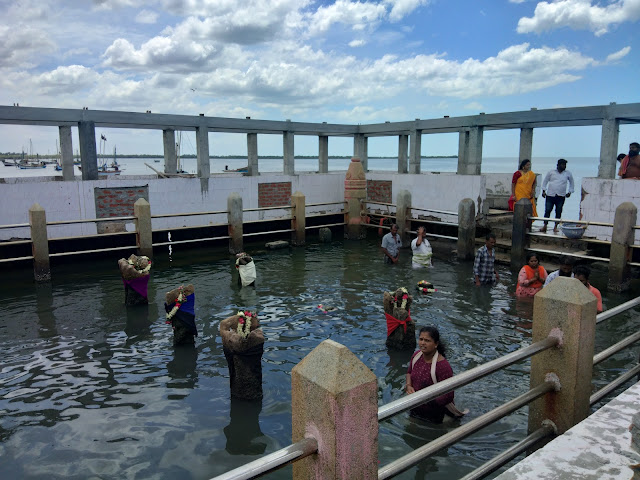

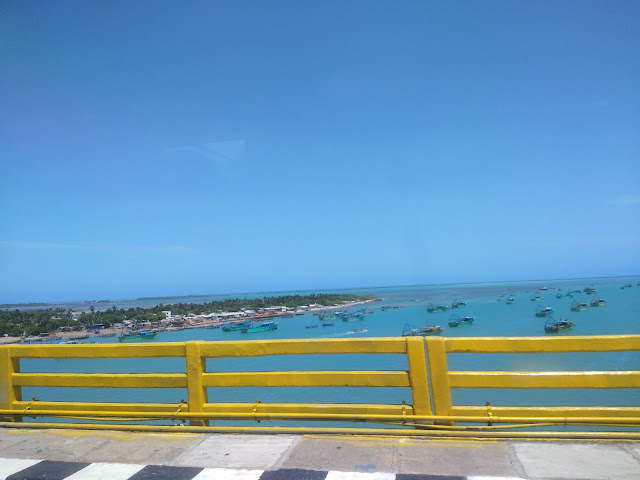



















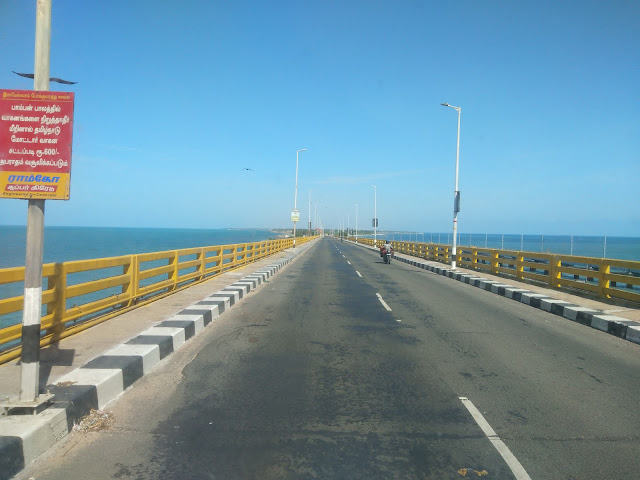


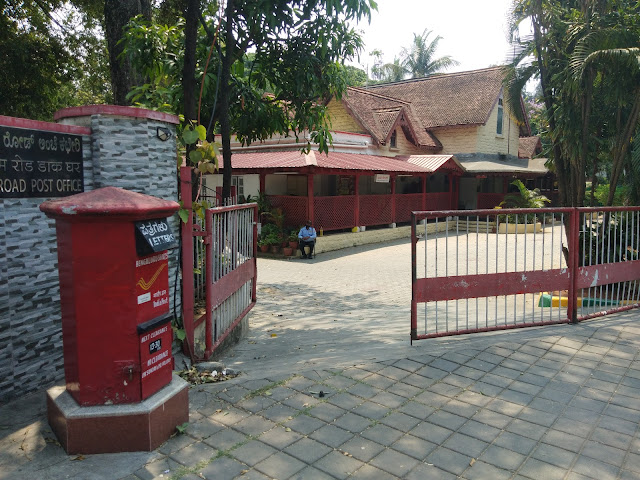
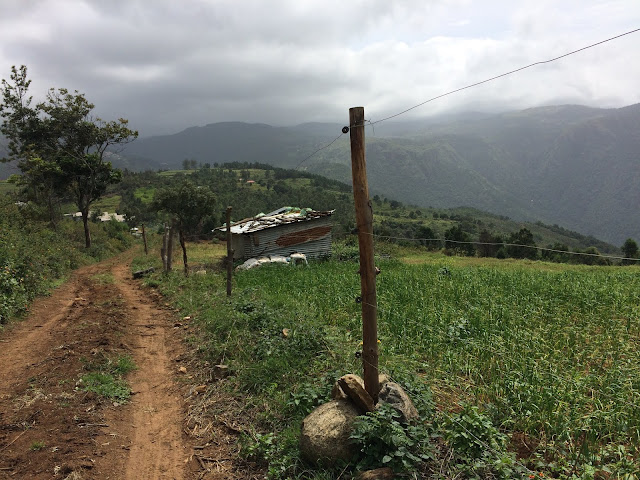
Comments
Post a Comment